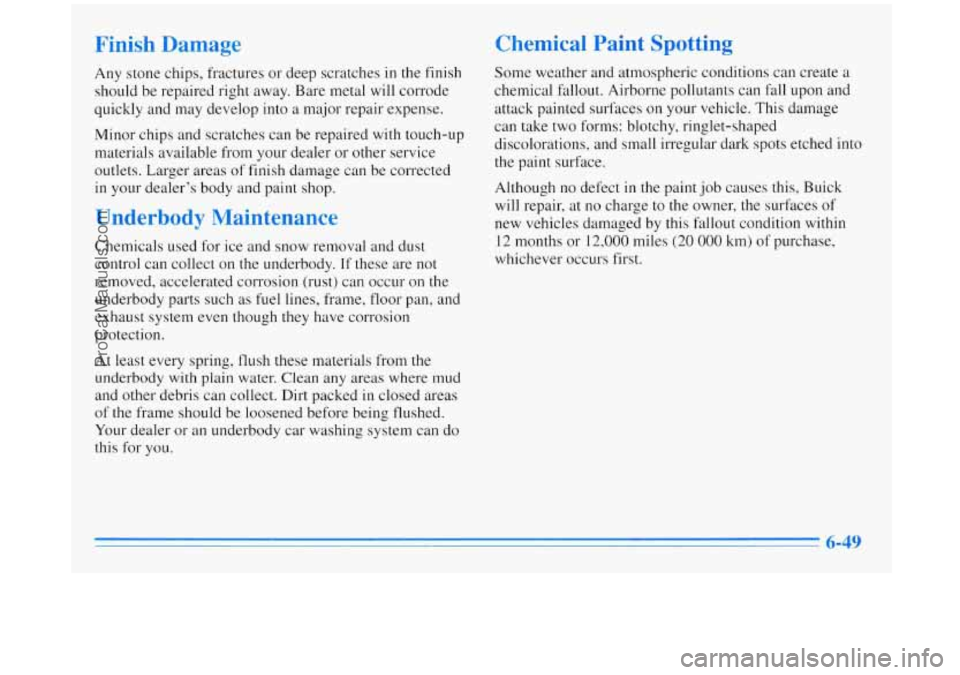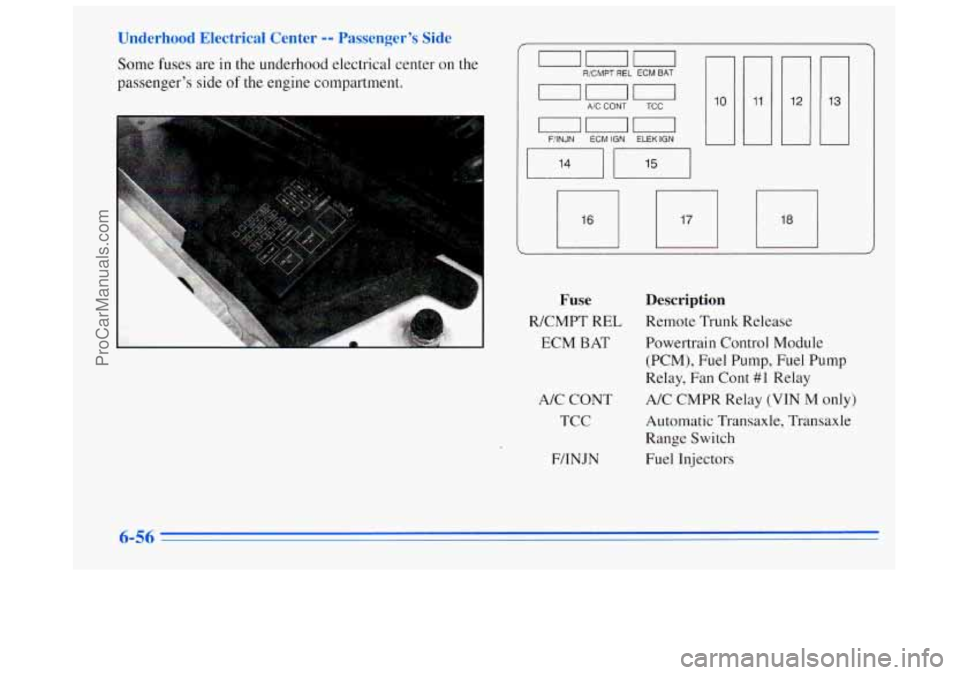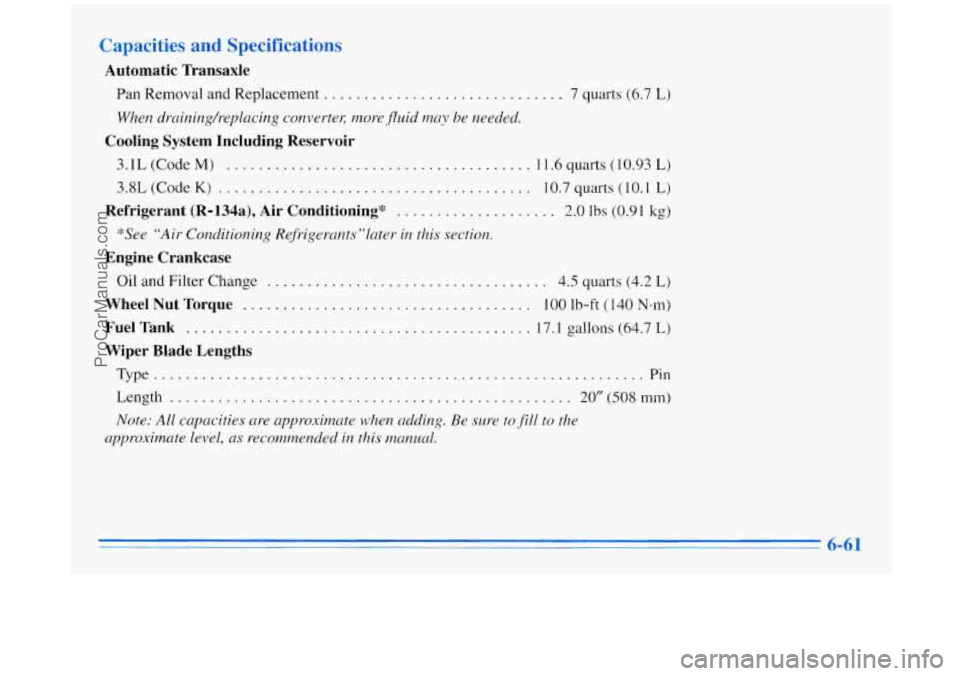1996 BUICK REGAL fuel
[x] Cancel search: fuelPage 271 of 356

Finish Damage
Any stone chips, fractures or deep scratches in the finish
should be repaired right away. Bare metal
will corrode
quickly and may develop into
a major repair expense.
Minor chips and scratches can be repaired with touch-up
materials available from your dealer or other service
outlets. Larger areas
of finish damage can be corrected
in your dealer’s body and paint shop.
Underbody Maintenance
Chemicals used for ice and snow removal and dust
control can collect on the underbody.
If these are not
removed, accelerated corrosion (rust) can occur on the
underbody parts such as fuel lines, frame, floor pan, and
exhaust system
even though they have corrosion
protection.
At least every spring, flush these materials from the
underbody with plain water. Clean any areas where mud
and other debris can collect. Dirt packed in closed areas
of the frame should be loosened before being flushed.
Your dealer or an underbody car washing system can do
this for you.
Chemical Paint Spotting
Some weather and atmospheric conditions can create a
chemical fallout. Airborne pollutants can fall upon and
attack painted surhces on your vehicle. This damage
can take two forms: blotchy, ringlet-shaped
discolorations, and small irregular dark spots etched into
the paint surface.
Although no defect
in the paint job causes this, Buick
will repair, at no charge to the owner, the surfaces of
new vehicles damaged by this fallout condition within
12 months or 12,000 miles (20 000 km) of purchase,
whichever occurs first.
6-49
ProCarManuals.com
Page 278 of 356

Underhood Electrical Center -- Passenger's Side
Some fuses are in the underhood electrical center on the
passenger's side
of the engine compartment.
ODD RICMPT REL ECM BAT
~~~ A!C CONT TCC
~~~ FllNJN ECM IGN ELEK IGN
--
I l4 II I -1 J
Fuse Description
R/CMPT REL Remote Trunk Release
ECM BAT Powertrain Control Module
(PCM),
Fuel Pump, Fuel Pump
Relay, Fan Cont
#1 Relay
A/C CONT
TCC
F/IN J N
A/C CMPR Relay (VIN M only)
Automatic Transaxle, Transaxle
Range
Switch
Fuel Injectors
6-56
ProCarManuals.com
Page 279 of 356

Fuse
ECM IGN
ELEK IGN
10
11
12
13
Description
Powertrain Control Module
(PCM), EGR, CCP, VAPSW,
Mass Air Flow (MAF) Sensor
(VIN
X only), Oxygen Sensor,
Vac Canister Switch, Fan
#2 Relay
Electronic Ignition (EI)
Control Module
I/P
Fuse Block
FAN CONT
#I Relay
Passenger’s Side Underhood
Electrical Center and
I/P Fuse
Blocks: Fuses
5, 14,23 and 32
FAN CONT
#2 Relay and UP Fuse
Block:
Fuse 16, Power Seat
Circuit Breaker
“D”
Relay
14
15
16
17
18
Description
FUEL PUMP
A/C CMPR
FAN CONT #2
-- Secondary
Cooling Fan (Passenger Side)
FAN CONT
#I -- Primary
Cooling Fan (Driver Side)
Ignition Relay
6-57
ProCarManuals.com
Page 283 of 356

Capacities and Specifications
Automatic Transaxle
Pan Removal and Replacement .............................. 7 quarts (6.7 L)
When draiizilzg/replacil.Ig convertec more,fluid may be needed.
Cooling System Including Reservoir
3.1L(CodeM) ...................................... 11.6quarts(10.93L)
3.8L (Code
K) ....................................... 10.7 quarts (10.1 L)
Refrigerant (R-l34a), Air Conditioning* .................... 2.0 lbs (0.91 kg)
*See “Air Conditioning Refriger~-lnts”l~~tel- in th,is section.
Engine Crankcase
Oil and Filter Change ................................... 4.5 quarts (4.2 L)
Wheel Nut Torque .................................... 100 Ib-ft (140 N.m)
Fuel Tank ........................................... 17.1 gallons (64.7 L)
Wiper Blade Lengths
Type ............................................................. Pin
Length
.................................................. 20”(508mm)
Note: All capacities are approximate when adding. Be sure to Jill to the
approximate level, as recommended in this manual.
6-61
ProCarManuals.com
Page 288 of 356

How This Section is Organized
The remainder of this section is divided into five parts:
“Part A: Scheduled Maintenance Services” shows
what to have done and how often. Some of these
services can be complex,
so unless you are technically
qualified and have the necessary equipment, you should
let your dealer’s service department
or another qualified
service center do these jobs.
Performing maintenance work on a vehicle can
be dangerous. In trying to do some jobs,
you can
be seriously injured.
Do your own maintenance
work only
if you have the required know-how
and the proper tools and equipment for the job.
If you have any doubt, have a qualified
technician do the work. “Part
B: Owner Checks and
Services’’ tells you what
should be checked whenever you stop for fuel.
It also
explains what you can easily do to help keep your
vehicle in good condition.
“Part
C: Periodic Maintenance Inspections”
explains important inspections that your Buick dealer’s service department or another qualified service center
should perform.
“Part
D: Recommended Fluids and Lubricants”
lists some products
GM recommends to help keep your
vehicle properly maintained. These products, or their
equivalents, should be used whether you do the work
yourself or have it done.
“Part
E: Maintenance Record’’ provides a place
for you to record the maintenance performed on your
vehicle. Whenever any maintenance is performed, be
sure to write it down in this part. This will help you
determine when your next maintenance should be done.
In addition, it is a good idea to keep your maintenance
receipts. They may be needed to qualify your vehicle for
warranty repairs.
If you are skilled enough to do some work on your
vehicle, you will probably want to get the service
information
GM publishes. See “Service and Owner
Publications” in the Index.
7-2
ProCarManuals.com
Page 289 of 356

Part A: Scheduled Maintenance
Services
Using Your Maintenance Schedule
We at General Motors want to help you keep your vehicle
in good working condition. But we don’t know exactly
how you’ll drive
it. You may drive very short distances
only a few times a week. Or you may drive long
distances all the time in very hot, dusty weather. You
may use your vehicle
in making deliveries. Or you may
drive it to work, to do errands or
in many other ways.
Because of all the different ways people use their GM
vehicles, maintenance needs vary. You may even need
more frequent checks and replacements than you’ll find
in the schedules in this section.
So please read this
section and note how you drive. If you have any
questions on how to keep your vehicle
in good
condition, see your Buick dealer.
This part tells you the maintenance services
you should
have done and when you should schedule them.
If you
go
to your dealer for your service needs, you’ll know
that GM-trained and supported service people will
perform the work using genuine GM parts. The
proper fluids and lubricants to
use are listed in
Part
D. Make sure whoever services your vehicle uses
these. All parts should be replaced and all necessary
repairs done before you or anyone else drives the vehicle.
These schedules are for vehicles that:
carry passengers and cargo within recommended
limits. You will find these limits on your vehicle’s
Tire-Loading Information label. See “Loading Your
Vehicle” in the Index.
are driven on reasonable road surfaces within legal
driving limits.
use the recommended fuel. See “Fuel” in the Index.
Selecting the Right Schedule
First you’ll need to decide which of the two schedules is
right for your vehicle. Here’s how to decide which
schedule to follow:
7-3
ProCarManuals.com
Page 290 of 356

Maintenance Schedule
I Short Trip/City Defition I
Follow the Short Trip/City Maintenance Schedule if any
one
of these conditions is true for your vehicle:
Most trips are less than 5 to 10 miles (8 to 16 km).
This is particularly important when outside
temperatures
are below freezing.
0 Most trips include extensive idling (such as frequent
driving
in stop-and-go traffic).
0 Most trips are through dusty areas.
0 You frequently tow a trailer or use a carrier on top
of your vehicle.
0 If the vehicle is used for delivery service, police,
taxi, or other commercial application.
One of the reasons you should follow this schedule if you
operate your vehicle under any of these conditions is that
these conditions cause erzgirze oil to break down soonex
Short Trip/City Intervals
Every 3,000 Miles (5 000 km): Engine Oil and Filter
Change (or
3 months, whichever occurs first).
Every 6,000 Miles (10 000 km): Chassis Lubrication
(or
6 months, whichever occurs first).
At 6,000 Miles (10 000 km) - Then Every
12,000 Miles (20 000 km): Tire Rotation.
Every 15,000 Miles (25 000 km): Air Cleaner Filter
Inspection, if driving
in dusty conditions.
Every 30,000 Miles (50 000 km): Air Cleaner Filter
Replacement.
Fuel Tank, Cap and Lines Inspection.
Every 50,000 Miles (83 000 km): Automatic Transaxle
Service (severe conditions only).
Every 60,000 Miles (100 000 km): Engine Accessory
Drive Belt Inspection.
Every 100,000 Miles (166 000 km): Cooling System
Service (or every
60 months, whichever occurs first).
Spark Plug Wire Inspection. Spark Plug Replacement.
These ilztervnls on.ly summarize mainteuance services.
Be sure to follow th.e complete maintenance schedule on
the following pages.
7-4
ProCarManuals.com
Page 291 of 356

Maintenance Schedule
Eg TripIHighway Definition
~~~ ~ ~~ ~
Follow this maintenance schedule only if none of the
conditions from the Short Trip/City Maintenance
Schedule is true.
Driving a vehicle with a fully warmed engine under
highway conditions causes engine oil to break
down sloweK
I Long Tripmighway Intervals
.. ..
Every 7,500 Miles (12 500 km): Engine Oil and Filter
Change (or every
12 months, whichever occurs first).
Chassis Lubrication (or every
12 months, whichever
occurs first).
At 7,500 Miles (12 500 km) - Then Every
15,000 Miles (25
000 km): Tire Rotation.
Every 30,000 Miles (50 000 km): Air Cleaner Filter
Replacement. Fuel Tank, Cap and Lines Inspection.
Every 50,000 Miles (83 000 km): Automatic Transaxle
Service (severe conditions only).
Every 60,000 Miles (100 000 km): Engine Accessory
Drive Belt Inspection.
Every 100,000 Miles (166 000 km): Cooling System
Service (or every
60 months, whichever occurs first).
Spark Plug Wire Inspection. Spark
Plug Replacement.
These intervals only summarize maintenance services.
Be sure to follow the complete maintenance schedule
on
the following pages.
ProCarManuals.com